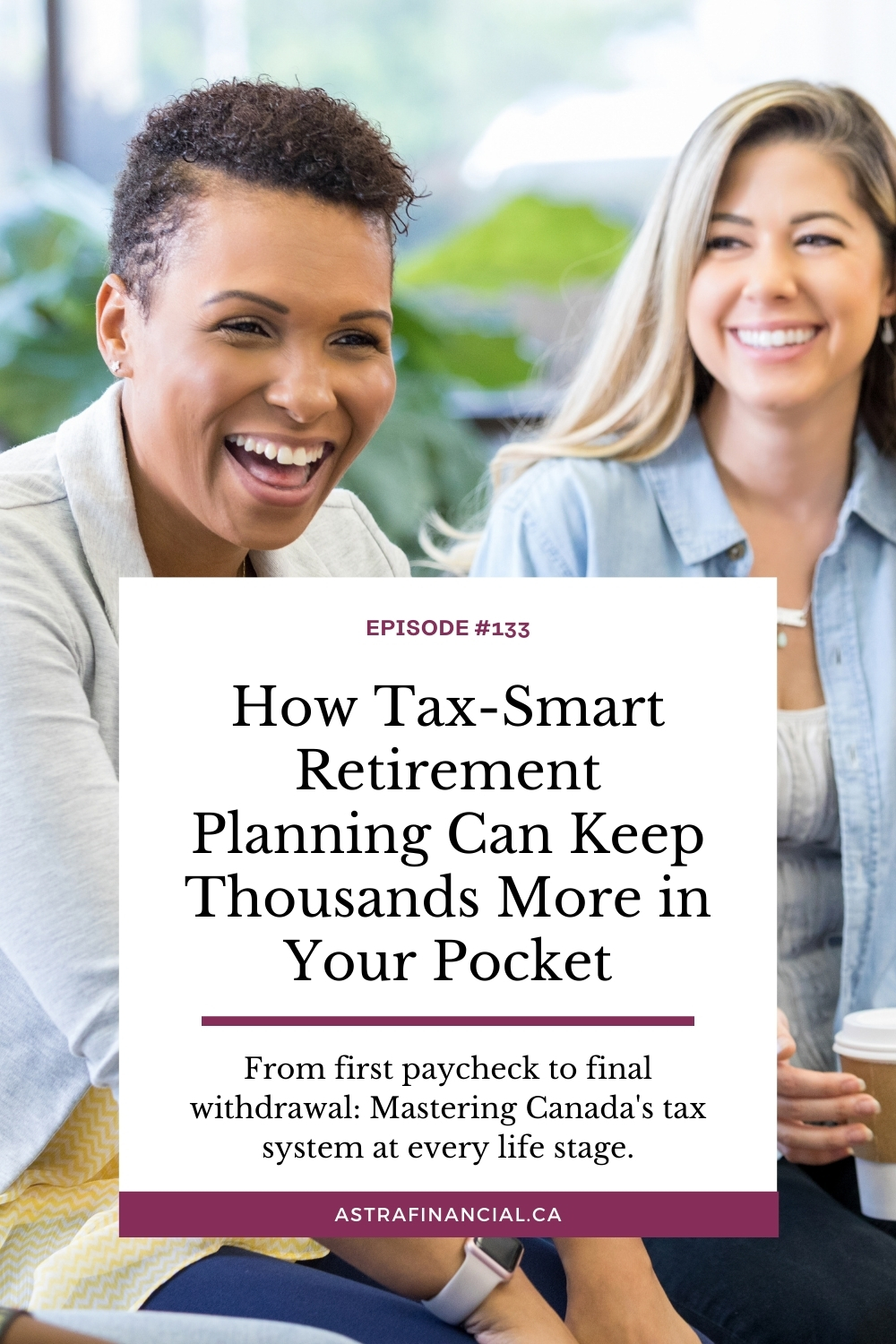Canadian Tax Rates 101 and Strategic Withdrawal Strategies

Whether you’re just receiving your first paycheck or mapping out your retirement, understanding Canada’s tax system is crucial for your financial well-being. Consider this your Canadian Tax Rates 101 Guides!
In this episode of Heart of Your Money, I break down marginal tax rates and progressive taxation in simple, practical terms. You’ll discover why that “next dollar earned” doesn’t push all your income into a higher tax bracket.
Tax-Smart Retirement Planning isn’t just about saving—it’s about strategic withdrawals that keep you in lower tax brackets. I share real examples, including how my husband’s retirement income only decreased by $850 monthly despite a “substantially lower” pension on paper.
From the “sprinkling effect” of diversified income sources to the often-misunderstood difference between tax credits and deductions, this episode offers practical strategies for every life stage.
Show Notes: Canadian Tax Rates 101 and Strategic Withdrawal Strategies
Hey there. Welcome back to the Heart of Your Money. I’m Zena, and today I’m diving into a topic that is perfect for our young adults out there and us that are contemplating and working on retirement. But this is especially important for our kids just starting out. Maybe it’s their first paycheck or it’s their first tax year that they’re actually paying attention and filing their taxes.
Since it is tax time right now, this might help them make sense of things like marginal tax rates and tax rates in Canada. So I know it is not all that exciting, but trust me, understanding this now could seriously pay off later. I’ll keep it short and simple, I promise. I’ve caught the plague so you can hear it, and if I stop to cough, I’ll pause for a minute. Hopefully Hailey, if you’re out there listening—she’s the editor and producer of everything magic here on the podcast—I’m sure she’ll edit it out. But I wanted to get this out because it’s timely, and because even with my own daughters filing their taxes, it’s just a confirmation of reiterating what our taxes are and where they come from.
And what is a tax bracket? In Canada, we use what’s called a progressive tax system. That means the more you earn, the higher your tax rate on that additional income. So think of it like steps and each step is a tax bracket. Here’s how it looks federally. For example, if you make 50—this is not just a random number, I found it on a chart—your first $57,375 is taxed at 15%. So income between $57,375 and $114,000 approximately gets taxed at 20.5%. So you can see that once you are over that threshold, then it jumps to that next step.
Let’s say you earn $60,000. Only the $2,625, so that amount over $57K approximately, that amount over it is all that gets taxed at that higher rate while the rest stays at 15%. And this is what I was trying to explain to my youngest in that she was disheartened in thinking—’cause I mean, what a great problem to have for her—starting to pay some taxes and having to realize that you’re in a higher tax bracket. And I was trying to explain that it’s not everything, it’s just up to that step and then the next step—anything above and beyond that will be taxed a little bit higher.
So what is a marginal tax rate then? When you hear the term marginal, your marginal tax rate is the tax you’ll pay on your next dollar earned. So it includes both federal and provincial taxes. For example, here in Saskatchewan in 2025, let’s say you make $60,000. Your federal marginal tax rate is 20.5% and Saskatchewan adds another 12.5%, so that’s bringing the combined marginal tax rate to about 33%. So for every extra dollar you will earn, 33 cents goes to taxes.
Now, why should we even care? Well, it seemed to matter a lot to my youngest when she started to realize—in planning and how much work being a self-employed person and a service provider based on how many hours you work and how many clients you see—she was starting to be like, “So why would I even work harder and work my butt off if I’m gonna be taxed at a higher bracket?” And so I had to go through this conversation with her and we actually did the tax planning.
Tax brackets and marginal rates play this role also in retirement planning because they affect how much we’ll pay on our retirement income. And I love to map this out. This is my nerdy joy, breaking it down and looking in advance so that we can map out savings now.
Breaking it down a little bit more clearly, the goal is lowering your taxable income in retirement. While you’re working, your income is usually higher, pushing you into that higher tax bracket. But in retirement, with the right planning, our goal shifts to reducing taxable income so you’re in a lower bracket, paying less overall. For instance, if your working income is $100K, some of that gets taxed federally at 26% federally. In retirement, if your income drops to $50,000 from pensions and RRSP withdrawals, most of it could be taxed at just 15%. This lower bracket can leave more money in your pocket than you think.
And so one of the examples I went through was with my husband and his retirement and his pension. His pension was substantially lower than his working income, but the take-home didn’t show that same disparity. So his net income that he received was actually only off by, you know, it could be like $850 a month. Even though on paper it looks like he’s making half of what he used to make, but it’s because he was in such a higher tax bracket that he had to pay so much more to taxes. So this is one example in that it wasn’t as depressing as he thought when we were crunching all the numbers. It was about take-home in your pocket.
Being mindful of marginal rates matters because that extra retirement income from your RRSP withdrawals, which is maybe now RRIFs, it can push you into a higher bracket. And I’m always analyzing and looking at that. So if your retirement income is $57,000, withdrawing an extra $5,000 could push some income into the next bracket, into that next tax bracket. So planning the withdrawals strategically helps avoid unnecessary higher taxes. That is actually what’s behind every single financial plan we do for our retiring clients.
So another point here is that your RRSPs, which turn into RRIFs, which is where the tap’s turned on, the timing actually matters. RRSP contributions lower your taxable income today, but withdrawals are fully taxed later. If you withdraw too much at once, you risk pushing into that higher bracket. It’s often smarter, this is just often generally, to spread withdrawals over several years to keep your taxes lower.
So another thing that’s part of this whole tax talk is tax credits and deductions. And this one I had a really hard time with—I didn’t explain it very well to my daughters, and so I thought, “Oh, I’m gonna just put it in the podcast.” And maybe they’ll listen to this. I often get asked from them when we’re talking about a tax deduction and a tax credit. And I get excited because I’m like, “Oh, we’ve got a credit!” And they’re like, “Oh good!” They thought they’d get it all back in cash, meaning if they had a tax credit.
So one common one for them was a tuition credit. They thought that they would get that immediately back in a tax return, cash in their hands. And so this is where I got confused and I was trying to explain to them tax deduction versus tax credit. So a tax deduction lowers your taxable income. For example, contributing to an RRSP reduces the income you’re taxed on.
So if you earned $60,000 and contributed $5,000 to an RRSP, you’re taxed only on $55,000. Now here’s what a tax credit is. This directly lowers the taxes you owe dollar for dollar. So a common one that I said for my daughters was tuition credit. Another one for you guys out there retired, or older—it doesn’t have to be schooling—it’s medical expenses is a tax credit. Donations is a tax credit, so it lowers the amount of tax we owe.
Knowing these differences help you take advantage of every possible savings at tax time. And when we go through tax returns and we take a look after, come in the next couple months, it’ll be looking through saying, “Okay, where can we add some tax credits?” We might be limited by the deductions because you can only deduct your income by so much under rules, under RRSP contributions. But if you’re retired, that’s gonna be pretty minimal. But that’s when we can focus on tax credits.
So a couple of things to keep in mind. Actual tips here that when it comes time to tax—spread your RRSP withdrawals to avoid larger tax hits, especially if you have large RRSPs. We sometimes turn on the tap a little bit earlier. I’ve talked about that a lot. Not all the time, but sometimes that’s one strategy.
The other one is using your Tax-Free Savings Account, the TFSA for funds. When you need that extra lump sum cash, maybe we’ve planned in there, we know, down the road you’re gonna have to buy a car. So we’re gonna take it from here because if you took it from your taxable income, then that throws you into the next tax bracket that I just explained.
Another one is split pension income if it lowers your overall taxes. If you’re doing your own taxes, it’s so smart. The programs out there, as long as you check a box or say “yes” if applicable, do split pension income. It’ll—it’s so smart—it’ll know what is pension splittable. But that’s something that has been really, really handy in our tax planning.
And another one is just diversify your income sources between those taxable buckets and non-taxable buckets. So that’s the non-registered and Tax-Free Savings Account. Sprinkling effect is what I’ve talked about in the past.
So understanding this, your marginal tax rates, it’s gonna be helpful and it ensures more comfortable and tax efficient retirement planning. That’s what it’s all about. And if you’ve got young people, send this to them, give them a little bit of a tax 101 because it’s super helpful as well.
That’s all I got today. Thanks for joining, and if this was helpful, if this episode was helpful, please subscribe. We’re trying to get our numbers up and share it with someone who needs to hear this. Until next time, keep it simple, stay informed and keep your money close to your heart.




